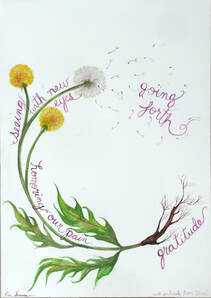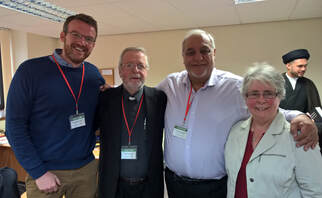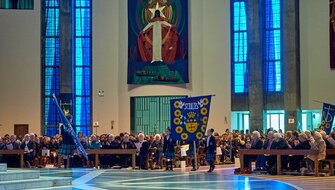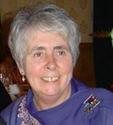
My retreat this year was different from usual. In a way it was more like a workshop though plenty of time for prayer and reflection. Its focus was the environment and care of the earth. It was held at An Tearsach, an ecological centre in Wicklow run by a community of Dominican sisters with a working bio-dynamic farm, organic shop and large garden which, as well as vegetables, fruit trees and flowers, has a cosmic garden. The centre of this is a spiral, much like a labyrinth, but, unlike the labyrinth, this one is walked from the middle, representing that moment when the Big Bang started the whole process of life through the eras of evolution out into the world of today. The retreat was led by a married couple, both third order Franciscans, who are the co-founders of Canticle Farm in Oakland, California and heavily involved in the work of Joanna Macy.
I didn’t know about this connection when I signed up for the retreat but I’ve been a long- time fan of her work. I first came across her book ‘World as Lover, World as Self’ in the 1990s. It made a great impression on me at the time. What has remained with me throughout the years is her meditation that leads the reader to take an imaginary journey beginning with one’s parents back through the generations to the moment when the journey of Homo Sapiens begins and then reverse the journey to the moment of one’s birth. Ever since then I’ve been aware of how I contain within myself the whole process of evolution and have been called forth (to use a religious term) from the beginning of time to be given form at this particular point in history.
This retreat engaged us in a process set out by Joanna Macy in her book ‘Active Hope’ and through conversation, reflection, poetry and a series of exercises offered a way of looking at the world with its possibilities for destruction and new life. It sought to engage us in the Great Turning – Joanna’s name for the move towards a life-sustaining world. It faced us with the question,’ what is ours to do’ in responding to the crisis our world is facing today with climate change, the destruction of hundreds of species, the loss of the rainforest and the unsustainability of much of our way of life. Each day we were drawn into the spiral for connecting to the earth and embracing the Great Turning.
We started with Gratitude – ‘for what we had, for what we are and for the possibilities that lie within each of us for ‘new frontiers … for living the life that we would love, for not postponing our dreams any longer and doing what each one of us came here for’ – to paraphrase John O’Donohue. We then moved to Honouring Our Pain. There’s something rather lovely about honouring our pain, not just feeling it. To honour our pain is somehow to embrace it, to reverence and respect it for, to believers, God who is present in all things, is to be found as much in pain as well as joy. On this day we reflected on how we coped with grief and loss, on our response to what is happening in the natural world. We listened to a litany of all those species that have become or are on the way to extinction. We built a cairn of mourning and remembered the words of Pope Francis in his encyclical on the environment Laudato Si “our goal is not to amass information or satisfy curiosity but rather to become painfully aware, to dare to turn what is happening in the world into our own personal suffering and thus discover what each of us can do about it”.
The next step in the spiral of the Great Turning is Seeing with New Eyes. We were led to expand our sense of self, understand the reality of interconnectedness and speak on behalf of another. And then we were at Going Forth, considering our response to what is ours to do and our intention in becoming part of this Great Turning.
The Great Turning is a hopeful and imaginative image for the movement towards a life-sustaining society. For Joanna Macy there’s evidence that it’s already happening with concern for justice and peace, awareness of the cosmos as a living system and efforts of many to live in communion with the earth. There are many ways in which we can participate in it. I was particularly pleased to hear that Jem Bendell, Professor of Sustainability at the University of Cumbria has outlined reconciliation as one of the skills necessary for the future. For me this means that interreligious dialogue which fits very nicely into the spiral can be part of the Great Turning and make a contribution, not just to peace in the world but to its sustainability and well-being.




 RSS Feed
RSS Feed
